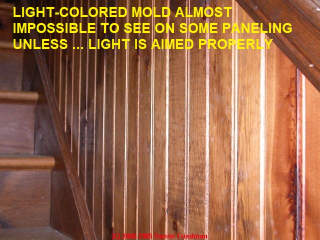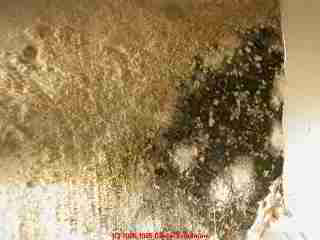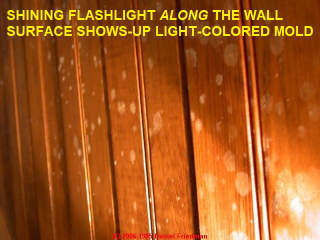 How to find hard to see mold in buildings
How to find hard to see mold in buildings
- POST a QUESTION or COMMENT about how to find hidden mold in buildings, both on exposed surfaces but hard to see and mold hidden in building cavities, insulation, or other areas
How to find hidden or hard-to-see mold in buildings:
As we detail in this "how to" article, the fact that mold is "hidden" in buildings, such as inside a wall cavity, does not mean one cannot find where the problem mold is located. We look for hidden mold contamination by context: where do we see leak stains, or where do we see building practices most likely to have produced a hidden leak or moisture problem?
Ice dam leaks in walls, hidden plumbing leaks, roof spillage by the foundation, are all common clues that often track to a wet building wall or ceiling cavity and from there to a hidden mold problem which may need to be addressed.
InspectAPedia tolerates no conflicts of interest. We have no relationship with advertisers, products, or services discussed at this website.
- Daniel Friedman, Publisher/Editor/Author - See WHO ARE WE?
How to Spot Hard-to-See Mold on Paneling or Other Surfaces in Buildings
USING LIGHT - Using proper lighting to see important mold contamination in buildings
 How you aim the light and where you shine an inspection light is of crucial importance when looking for mold in buildings.
How you aim the light and where you shine an inspection light is of crucial importance when looking for mold in buildings.
Light-colored mold such as some members of the Aspergillus sp. and Penicillium sp. groups are often the dominant problem-mold in buildings but these offenders are often missed by a casual inspection because they can be hard to see on surfaces.
You need a bright flashlight and you need to know how to use it.
Shine the light along the surface being examined, not straight at it.
As you'll see in the mold photographs below, using your light carefully can make a big difference in what mold you find and where you find it.
Just looking for "black mold" risks missing the important mold in a building.
Light colored mold next to obvious black mold:
Aiming a bright flashlight along this wall surface where dark mold wasobvious shows a light gray/green fungal colony which in fact was far more toxic and thus important to select as an additional source for surface sampling using adhesive tape.
Light colored toxic mold on paneling can be hard to see in ordinary lighting and requires careful inspection.
But notice how the lighting shows that this paneling is buckled.
We 'd suspect that it has been exposed to high moisture if not water, and that there is risk of hidden mold on the cavity side of this material.
Further inspection was needed.
Light colored toxic mold on paneling is not visible because light is being shone directly onto the wainscot wood paneling surface.
Now try shining a light along the surface - this easily shows the white mold colony.
The point of these illustrations is to demonstrate that "hidden mold", like the purloined letter, may in fact be hiding in plain view - you just don't know how to see it.
Is Toxic Black Mold the Only Mold To Worry About in Buildings?
In short, no, absolutely not. Here are some details:
Recent news articles have made some people terrified at the mere mention of "toxic black mold" such as "Stachybotrys chartarum." Actually it is common to find Stachybotrys chartarum in small amounts in houses where there has been prolonged leakage or water entry. It's a toxic mold that should be removed.
But don't assume that anything and everything black on a building wall is a highly toxic mold. Some black stuff is not mold at all. See STUFF THAT IS NOT MOLD for details of black stains or debris on walls that have no mold hazard whatsoever.
Other common mold species look black but may be of low or no toxicity. For example, Chaetomium globosum has been reported to be allergenic rather than toxic. Cladosporium sphaerospermum is often found growing indoors on bathroom tile or refrigerator gaskets. It's a member of the most common mold family, Cladosporium, the "universal fungus." It can look pretty "black" on some surfaces.
Still other black molds found in buildings are completely harmless. See Recognize Cosmetic Mold and Recognize Harmless Black Mold for details about these cosmetic molds and easy ways to spot some of them with no testing whatsoever. Just common sense can tell you that some molds have been on a surface since the time of construction.
Finally, there are plenty of highly toxic or highly allergenic or irritating molds found in buildings that are not black or even dark, especially including most members of the Aspergillus sp. and Penicillium sp. families. See LIGHT COLORED MOLD for details.
Is it Possible to Identify a Mold Just by Looking At It On a Building Surface?
Can you tell what genera or species a mold is that's growing on a surface just by the naked eye?
No. Though I've inspected and tested so many molds on so many surfaces that like a bird watcher, I know what's likely to be present in a given habitat. (Refrigerator gasket mold is usually a Cladosporium, often C. sphaerospermum and mold growing on window muntins will be a genera/species tolerant of UV light. A normal person can't do this, though a mold investigator and a few mold remediators with plenty of experience can make a reasonable guess. (Such guesses are not always right.)
You cannot determine the mold genera and species just by looking at mold on the wall. Skip those do-it-yourself mold test kits that rely on culture or settlement plates. The methods the kits use are fundamentally inaccurate and in a few cases so are their laboratories. (90% of mold species will not grow on culture media.)
For small mold problems, spend your money on some soap and water instead.
For larger mold contamination problems hire an expert to survey your home, or send your own mold
sample to a competent testing laboratory. The services of an experienced mycologist or
aerobiologist are necessary to know what you've got.
© DJF Copyright protection trap.© Daniel Friedman
This article series describes how to find mold and test for mold in buildings, including how and where to collect mold samples using adhesive tape - an easy, inexpensive, low-tech but very effective mold testing method. This procedure helps identify the presence of or locate the probable sources of mold reservoirs in buildings, and helps decide which of these need more invasive, exhaustive inspection and testing.
...
Continue reading at HIDDEN MOLD in CEILING / WALL CAVITY or select a topic from the closely-related articles below, or see the complete ARTICLE INDEX.
Or see
HIDDEN MOLD, HOW TO FIND - home
MOLD APPEARANCE - WHAT MOLD LOOKS LIKE
MOLD in BUILDINGS and see MOLD GROWTH on SURFACES for an index of what mold genera/species are frequently found on various building surfaces and materials.
Suggested citation for this web page
HARD TO SEE MOLD, SPOTTING at InspectApedia.com - online encyclopedia of building & environmental inspection, testing, diagnosis, repair, & problem prevention advice.
Or see this
INDEX to RELATED ARTICLES: ARTICLE INDEX to MOLD CONTAMINATION & REMEDIATION
Or use the SEARCH BOX found below to Ask a Question or Search InspectApedia
Ask a Question or Search InspectApedia
Questions & answers or comments about how to find hidden mold in buildings, both on exposed surfaces but hard to see and mold hidden in building cavities, insulation, or other areas.
Try the search box just below, or if you prefer, post a question or comment in the Comments box below and we will respond promptly.
Search the InspectApedia website
Note: appearance of your Comment below may be delayed: if your comment contains an image, photograph, web link, or text that looks to the software as if it might be a web link, your posting will appear after it has been approved by a moderator. Apologies for the delay.
Only one image can be added per comment but you can post as many comments, and therefore images, as you like.
You will not receive a notification when a response to your question has been posted.
Please bookmark this page to make it easy for you to check back for our response.
IF above you see "Comment Form is loading comments..." then COMMENT BOX - countable.ca / bawkbox.com IS NOT WORKING.
In any case you are welcome to send an email directly to us at InspectApedia.com at editor@inspectApedia.com
We'll reply to you directly. Please help us help you by noting, in your email, the URL of the InspectApedia page where you wanted to comment.
Citations & References
In addition to any citations in the article above, a full list is available on request.
- Fifth Kingdom, Bryce Kendrick, ISBN13: 9781585100224, - we recommend the CD-ROM version of this book. This 3rd/edition is a compact but comprehensive encyclopedia of all things mycological. Every aspect of the fungi, from aflatoxin to zppspores, with an accessible blend of verve and wit. The 24 chapters are filled with up-to-date information of classification, yeast, lichens, spore dispersal, allergies, ecology, genetics, plant pathology, predatory fungi, biological control, mutualistic symbioses with animals and plants, fungi as food, food spoilage and mycotoxins.
- Fungi, Identifying Filamentous, A Clinical Laboratory Handbook, Guy St-Germain, Richard Summerbell, Star Publishing, 1996, ISBN 0-89863-177-7 (English)
- In addition to citations & references found in this article, see the research citations given at the end of the related articles found at our suggested
CONTINUE READING or RECOMMENDED ARTICLES.
- Carson, Dunlop & Associates Ltd., 120 Carlton Street Suite 407, Toronto ON M5A 4K2. Tel: (416) 964-9415 1-800-268-7070 Email: info@carsondunlop.com. Alan Carson is a past president of ASHI, the American Society of Home Inspectors.
Thanks to Alan Carson and Bob Dunlop, for permission for InspectAPedia to use text excerpts from The HOME REFERENCE BOOK - the Encyclopedia of Homes and to use illustrations from The ILLUSTRATED HOME .
Carson Dunlop Associates provides extensive home inspection education and report writing material. In gratitude we provide links to tsome Carson Dunlop Associates products and services.



